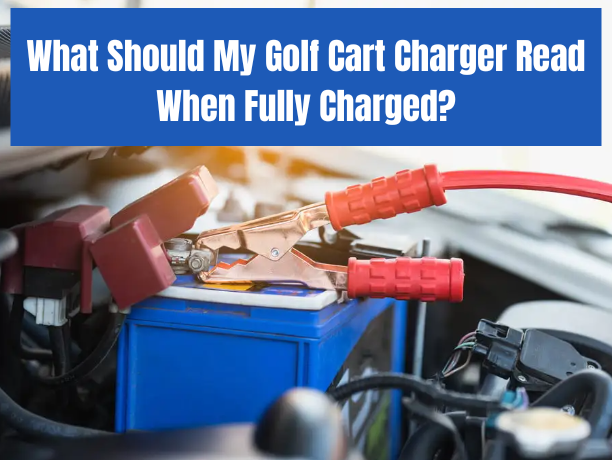What Should My Golf Cart Charger Read When Fully Charged?
The battery is one of a golf cart’s most crucial pieces. Ensuring that the battery is fully charged is essential to keep the golf cart running smoothly. However, many golf cart owners are unsure of what their chargers should read when their batteries are fully charged. If your golf cart has a 48V battery containing 8-volt batteries, it should read 8.2-8.3 volts per battery and a total of 49.2-49.8 volts. While if you have a 36V battery containing 6-volt batteries, it should read 6.2-6.3 and a total of 37.2-38 volts when fully charged.

If you have a 36V battery with 6-volt batteries and it reads around 4 volts when fully charged, then you are facing a battery problem. In such a situation, you must replace your battery. Moreover, overcharging and undercharging your battery affects its health. Therefore, it’s crucial to look after your batteries. This article will discuss what a golf cart charger should read when fully charged and how to properly handle your golf cart battery.
Golf Charger Working
Firstly, it is important to understand the basics of how a golf cart charger works. A golf cart charger works by using DC power to charge the batteries. Once the charger is connected to the golf cart, it will begin to charge the batteries. As the batteries charge, the voltage and current flowing into the batteries will gradually decrease until the batteries are fully charged.
Indications that your Battery is Fully Charged
A battery usually takes a total of 10-12 hours to charge, depending on the charger fully. So you should charge your golf cart batteries overnight, so they are ready to perform in the morning. The following are the indications that help you understand if your battery is fully charged or not. Do you know what happens to your golf batteries in winter?
- When the batteries are fully charged, the charger should read a voltage between 38 and 49 volts, depending on the specific type of battery used in the golf cart.
- For a 36V battery, a charger should read between 37-38 volts (6.2-6.3 volts for each battery cell).
- For a 48V battery, a charger should read between 49.2-49.8 volts (8.2-8.3 volts for each battery cell).
- The charger should also read a current of zero or near zero, indicating that the batteries are no longer drawing any current from the charger.
- Moreover, there is a light present at the top of your battery that indicates if your battery is fully charged or not.
- A red light indicates that there is some charging error.
- A short green light indicates less than 80% charged battery.
- A long green light indicates more than 80% charged battery.
- A continuous green light indicates that your battery is fully charged.
It is important to note that different golf carts may have different charging requirements, depending on the battery type and the manufacturer’s recommendations. Therefore, it is always advisable to refer to the golf cart owner’s manual or consult a professional technician. They will tell you how to determine the correct charging requirements for your golf cart.
How should your golf cart batteries be maintained?
On the golf course, at campgrounds, and in retirement communities, golf carts have grown in popularity as a mode of transportation. It’s crucial to take good care of your golf cart battery if you want it to serve you for an extended period of time. Here are some pointers on how to maintain a golf cart battery:
1. Regularly Charge the Battery
After each use, golf cart batteries need to be recharged. The battery’s lifespan can be shortened if it is left discharged for an extended period of time.
2. Store the Battery Properly
When storing your golf cart for an extended period, it’s critical to treat the battery carefully. Keep the battery charged and place it in a dry, cool place to store. The battery may need to be periodically charged to avoid damage if it isn’t used for a long time.
3. Use the Right Charger
Golf cart batteries require a specific type of charger, so it is important to use the right one. The incorrect charger can harm the battery or even pose a safety risk.
4. Check Water Levels
Golf cart batteries are lead-acid batteries and require distilled water to function properly. It is essential to check the water levels in the battery cells regularly and top them off with distilled water if needed. If the water level is too low, the battery can become damaged and need replacement.
5. Keep the Battery Clean
Keep the battery clean because corrosion, dirt, and other particles can assemble on the battery terminals and lead to battery problems. Regularly use a wire brush to clean the battery terminals, and then use a corrosion inhibitor to stop further buildup.
6. Replace the Battery when needed
Golf cart batteries only last so long, typically between 3-5 years. If the battery is no longer holding a charge or is not functioning properly, it may be time to replace it.
How do you know if your charger or battery is at fault?
Golf carts are electric vehicles that are powered by rechargeable batteries. Golf carts require routine maintenance and care to ensure their longevity and effectiveness, just like any other battery-powered device. However, golf cart owners sometimes face issues with their battery or charger, which can be difficult to diagnose. Follow these points with careful inspection and testing to check whether your charger is at fault or your battery.
When your Charger is not Working
Firstly, if your golf cart is not charging or takes longer to charge than usual, it may indicate a problem with the charger. You can start by checking the charger’s connections and making sure they are clean and free of debris.
Additionally, try plugging in a different device to see if the power outlet is operating properly. If the outlet is functioning properly, you can check the output voltage of the charger. A faulty charger may not provide sufficient voltage to charge or overcharge the battery, leading to premature battery failure.
When your Battery is not Working
- If your golf cart battery is not holding a charge, it may indicate a problem with the battery. Start by inspecting the battery connections to make sure they are tidy and secure. A weak or dead battery may result from voltage drops caused by weak or corroded interconnection.
- Additionally, make sure the battery has enough water and, if necessary, top it off with distilled water. The battery may dry out due to low water levels, which can result in internal damage and shorter battery life.
- If your golf cart has reduced power and is slowing down, it may indicate a battery problem. The batteries may be weak or dead, leading to reduced power output.
- A voltmeter can be used to measure the battery voltage and compare it to the manufacturer’s recommendations. If the voltage is lower than the specified range, it may indicate a faulty battery that needs to be replaced.
- Additionally, you can load-test the battery to determine its capacity. In a load test, a load is applied to the battery, and the voltage drop over time is measured. A healthy battery should maintain a stable voltage under load, while a weak battery may show a significant voltage drop. A load test can help you determine if the battery is faulty and needs to be replaced.
Conclusion
In conclusion, a golf cart charger should read a voltage between 38 and 48 volts and a current of zero near zero when the batteries are fully charged. However, it is essential to refer to the golf cart owner’s manual or consult with a professional technician to determine the correct charging requirements for your specific golf cart. By ensuring that your golf cart batteries are fully charged, you can prolong their lifespan and keep your golf cart running smoothly.
Overcharging or undercharging the batteries can cause damage and reduce their lifespan, so it is essential to ensure that the batteries are fully charged without overcharging them. Some chargers come equipped with automatic shut-off features that prevent overcharging, while others may require manual monitoring to prevent overcharging.

I am William N. Adams and my love affair with golf has been a lifelong journey. As an avid golfer and passionate writer, I have immersed myself in the world of golf, seeking to share my insights, experiences, and expertise with fellow enthusiasts. Being a contributing author for Golf-Birdie, a renowned golf website, allows me to combine my two greatest passions into one fulfilling endeavor.






